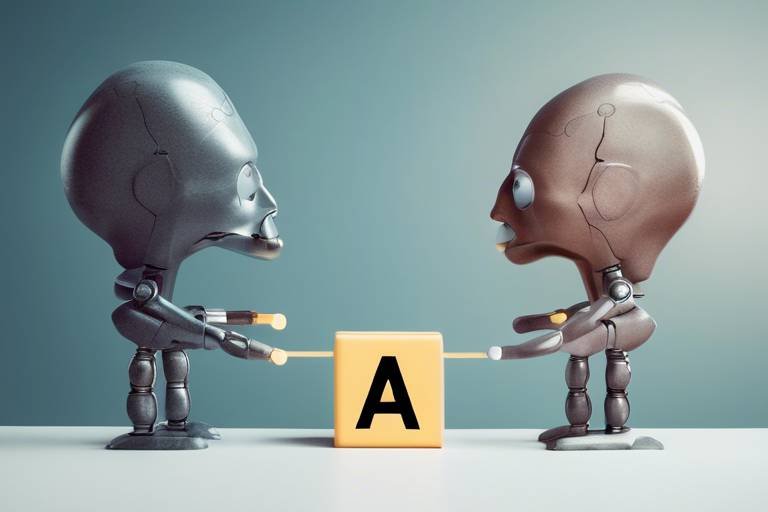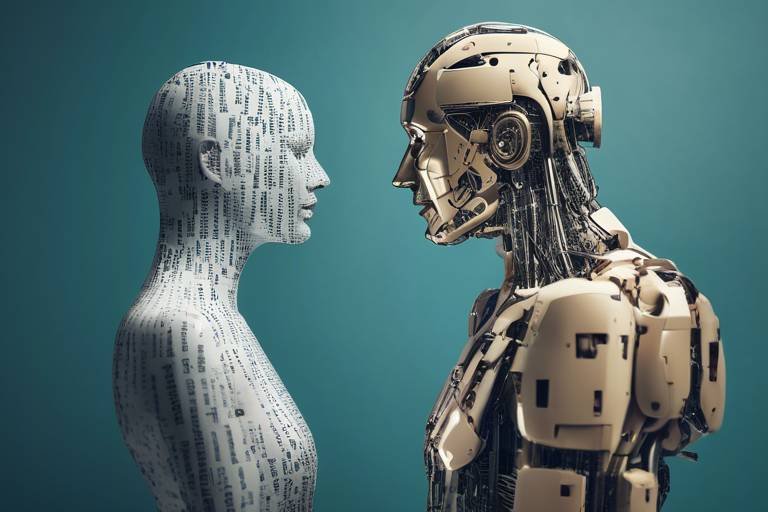Decoding the Ethics in AI: A Deep Dive
As we stand on the brink of a technological revolution, the emergence of artificial intelligence (AI) has sparked a whirlwind of discussions about its ethical implications. The question isn't just about what AI can do, but rather, what it should do. With AI systems being integrated into everything from healthcare to finance, understanding the ethical considerations surrounding these technologies is crucial. This exploration is not merely academic; it's a pressing necessity for ensuring that advancements in AI serve humanity positively, rather than leading to unintended consequences.
Imagine a world where AI systems make decisions that affect our lives—like hiring processes, loan approvals, and even medical diagnoses. These decisions can have profound impacts, and if not governed by ethical principles, they can lead to discrimination, injustice, and a loss of trust in technology. The ethical landscape of AI is complex and multifaceted, demanding a rigorous examination of how these systems are designed, implemented, and governed. By diving deep into the ethics of AI, we can better understand the responsibilities that come with creating intelligent systems.
Furthermore, the ethical considerations surrounding AI are not just about avoiding harm; they also encompass the promotion of beneficial outcomes. For instance, how can AI be harnessed to address societal challenges like climate change or inequality? The potential for AI to drive positive change is enormous, but it requires a commitment to ethical practices that prioritize human values. As we decode the intricacies of AI ethics, we must also consider the role of stakeholders—from developers and corporations to policymakers and the general public—in shaping a future where technology aligns with our collective goals.
In this article, we will explore the importance of ethical AI, key principles that guide its development, and the challenges we face in ensuring accountability and transparency. By the end of this deep dive, we hope to illuminate the path forward for responsible AI development, fostering a dialogue that encourages innovation while safeguarding our ethical standards.
Understanding why ethics in AI is crucial helps us navigate the complex landscape of technology, ensuring that advancements benefit society while minimizing harm. AI has the potential to revolutionize industries, but without a strong ethical framework, we risk creating systems that reinforce existing biases and inequalities. The importance of ethical AI cannot be overstated; it's about ensuring that technology serves the greater good, rather than becoming a tool for oppression or discrimination.
Exploring foundational ethical principles such as fairness, accountability, and transparency can guide the responsible development and implementation of AI technologies. These principles act as a compass, directing developers and organizations toward practices that prioritize human rights and societal welfare. By adhering to these principles, we can foster a culture of responsibility in AI development, ensuring that technology evolves in a way that aligns with our ethical values.
Fairness addresses biases in AI algorithms, ensuring equitable treatment across different demographics and preventing discrimination in decision-making processes. It's essential to recognize that AI systems learn from existing data, which can be tainted with biases. If we don't actively work to mitigate these biases, we risk perpetuating inequalities in our societies.
Recognizing inherent biases in data sets is essential for developing fair AI systems, as these biases can lead to unfair outcomes in various applications. For example, if an AI system is trained on historical hiring data that reflects past discriminatory practices, it may inadvertently replicate those biases. This highlights the need for vigilance in data collection and analysis, ensuring that we are aware of the potential pitfalls.
Strategies for mitigating biases include diverse data collection, algorithmic adjustments, and continuous monitoring to ensure fairness throughout the AI lifecycle. By implementing these strategies, developers can create AI systems that are more equitable and just. It's not just about building better technology; it's about building a better society.
Establishing clear accountability measures is vital for holding developers and organizations responsible for the ethical implications of their AI systems. Without accountability, there is little incentive to prioritize ethical considerations, which can lead to harmful consequences. It's crucial that organizations take ownership of their AI systems, ensuring that they are designed and deployed in ways that align with ethical standards.
Transparency in AI processes fosters trust and allows users to understand how decisions are made, which is crucial for ethical compliance. When users can see the inner workings of AI systems, they are more likely to trust them. This transparency is essential for building a relationship between technology and society, where users feel empowered rather than manipulated.
Explainability ensures that AI systems provide understandable reasoning behind their decisions, allowing stakeholders to assess their fairness and reliability. If an AI system makes a decision that significantly impacts a person's life, they deserve to know why that decision was made. This not only promotes trust but also encourages ongoing dialogue about the ethical implications of AI technology.
The development of regulatory frameworks is necessary to enforce ethical standards in AI, ensuring compliance and promoting responsible innovation across industries. These frameworks can serve as guardrails, guiding organizations in their AI practices and fostering a culture of accountability and transparency. As we navigate the evolving landscape of AI, robust regulatory measures will be essential in ensuring that technology serves humanity ethically and responsibly.
- What is the importance of ethics in AI? Ethics in AI ensures that technology benefits society while minimizing harm and preventing discrimination.
- How can biases in AI be identified and mitigated? By recognizing biases in data sets and implementing strategies like diverse data collection and algorithmic adjustments.
- Why is transparency important in AI? Transparency fosters trust and allows users to understand the decision-making processes of AI systems.
- What role do regulatory frameworks play in AI ethics? They enforce ethical standards and promote responsible innovation across industries.

The Importance of Ethical AI
In today's fast-paced world, where technology is evolving at lightning speed, the importance of ethical AI cannot be overstated. Imagine a world where machines make decisions that affect our lives—everything from hiring processes to healthcare diagnostics. It's a bit like giving a teenager the keys to the family car without teaching them how to drive, right? We need to ensure that these powerful tools are designed and implemented responsibly, or we risk creating more problems than solutions.
Ethical AI serves as a guiding star, helping us navigate the murky waters of artificial intelligence development. When we think about the implications of AI, we must consider how it impacts society as a whole. It's not just about creating smarter algorithms; it's about ensuring that these advancements lead to positive outcomes. With ethical guidelines in place, we can work towards a future where AI benefits everyone, not just a select few. This is particularly crucial as AI systems become more integrated into our daily lives, influencing everything from our shopping habits to how we interact with government services.
Moreover, the ethical considerations surrounding AI are essential for fostering trust among users. If people feel that AI systems are biased or opaque, they are less likely to embrace these technologies. Trust is the bedrock of any successful relationship, including the one between humans and machines. By prioritizing ethical practices, we can build AI systems that are not only effective but also transparent and reliable. This is akin to having a recipe for a delicious dish; if the ingredients are of poor quality, the end result will be disappointing. In the same way, if we neglect ethical considerations, the consequences could be dire.
To further emphasize the importance of ethical AI, consider the following points:
- Social Responsibility: Developers and organizations must recognize their role in shaping society. Ethical AI ensures that technology is used for the greater good.
- Risk Mitigation: By addressing ethical concerns upfront, we can reduce the risks of harm that might arise from AI deployment.
- Innovation Encouragement: Ethical guidelines can actually spur innovation by encouraging developers to think creatively about solving problems responsibly.
In conclusion, the importance of ethical AI extends beyond mere compliance with regulations. It's about fostering a culture of responsibility, trust, and innovation. As we stand on the brink of a new technological era, we must ask ourselves: Are we ready to embrace the challenges that come with these powerful tools? By prioritizing ethics in AI, we can ensure that we are not just creating smarter machines but also a better world for everyone.

Key Ethical Principles
The ethical landscape of artificial intelligence (AI) is multifaceted and complex, requiring us to anchor our understanding in a few key principles that guide responsible development and deployment. These principles serve as a moral compass, ensuring that technology serves humanity rather than the other way around. At the heart of this discussion are three fundamental ethical principles: fairness, accountability, and transparency. Each of these principles plays a crucial role in shaping how AI technologies impact our lives and society at large.
Fairness is perhaps the most discussed principle in AI ethics. It addresses the urgent need to recognize and eliminate biases in AI algorithms. Imagine a world where an AI system decides who gets a loan or a job based on skewed data—it’s a scenario that could lead to discrimination and inequality. To combat this, we must ensure equitable treatment across different demographics. Fairness in AI isn't just a buzzword; it’s a necessity for fostering trust and inclusivity in our digital age.
Next on the list is accountability. In a realm where decisions can be made by algorithms, establishing clear accountability measures becomes vital. Who is responsible when an AI system makes a mistake? Is it the developers, the organizations, or perhaps the AI itself? Without clear lines of accountability, we risk a future where unethical decisions go unchecked. Developers and organizations must be held responsible for the ethical implications of their AI systems, creating a culture of accountability that permeates every level of AI development.
Finally, we arrive at transparency. This principle is about more than just opening the black box of AI; it’s about fostering trust and understanding among users. When AI systems make decisions, stakeholders need to know how and why those decisions were made. Transparency allows users to assess the fairness and reliability of AI systems, making it easier to challenge or support their outcomes. For instance, if an AI denies a loan application, the applicant should be able to understand the reasoning behind that decision. This transparency is crucial for ethical compliance and builds a foundation of trust between AI developers and users.
To summarize, the key ethical principles of AI—fairness, accountability, and transparency—are not just theoretical constructs; they are essential guidelines that must be integrated into every stage of AI development. By adhering to these principles, we can navigate the complexities of AI technology while ensuring that it benefits society as a whole.
- What is the importance of fairness in AI?
Fairness ensures that AI systems do not perpetuate existing biases, leading to equitable outcomes for all users. - How can accountability be established in AI?
Clear accountability measures can be established by defining roles and responsibilities for developers and organizations involved in AI systems. - Why is transparency crucial in AI?
Transparency allows users to understand how AI systems make decisions, fostering trust and enabling them to challenge or support outcomes.

Fairness in AI Systems
When we talk about , we're diving into a crucial aspect that can make or break the technology's impact on society. Imagine a world where decisions about your job application, loan approval, or even medical treatment are dictated by algorithms that might be biased. Sounds a bit scary, right? That's why ensuring fairness in AI is not just a technical challenge; it's a moral imperative. Fairness addresses the biases that can seep into AI algorithms, ensuring that all individuals, regardless of their background, are treated equitably. This is about leveling the playing field and preventing discrimination in decision-making processes.
To grasp the concept of fairness in AI, we first need to recognize that biases can be inherent in the data sets used to train these algorithms. If the data reflects historical inequalities or societal prejudices, the AI systems trained on this data are likely to perpetuate those biases. For instance, if an AI system is trained on data that predominantly features one demographic group, it may not perform as accurately for individuals from other groups. This is not merely a technical oversight; it can lead to real-world consequences, such as unfair hiring practices or unjust legal outcomes.
Identifying these biases is the first step in developing fair AI systems. It involves a thorough examination of the data and the algorithms that process it. Developers must ask themselves critical questions: What data are we using? Who does it represent? Are there any groups that are underrepresented or misrepresented? By shining a light on these questions, we can begin to uncover potential biases lurking in our datasets.
Once we identify biases, the next step is to mitigate them. This can be achieved through several strategies, including:
- Diverse data collection: Ensuring that data sets include a wide range of demographics is crucial. The more representative the data, the less likely it is to produce biased outcomes.
- Algorithmic adjustments: Sometimes, tweaking the algorithms themselves can help counteract inherent biases. This might involve changing how certain features are weighted or introducing new variables that reflect fairness.
- Continuous monitoring: Fairness is not a one-time fix. It requires ongoing assessment and adjustment to ensure that AI systems remain fair throughout their lifecycle.
In conclusion, fairness in AI systems is a multifaceted challenge that requires a proactive approach. By identifying and mitigating biases, we can create AI technologies that not only perform effectively but also uphold the principles of justice and equality. This isn't just a tech issue; it's a societal one. As AI continues to evolve, we must prioritize fairness to ensure that its benefits are shared by all.
- What is fairness in AI? Fairness in AI refers to the principle that AI systems should operate without bias, ensuring equitable treatment across different demographic groups.
- How can biases in AI be identified? Biases can be identified through careful examination of the data sets used for training and by asking critical questions about representation and fairness.
- What strategies can help mitigate biases in AI? Strategies include diverse data collection, algorithmic adjustments, and continuous monitoring of AI systems.

Identifying Biases
When we talk about artificial intelligence, one of the most crucial aspects to consider is the concept of bias. Bias in AI isn't just a technical glitch; it can have real-world consequences that affect people's lives. Imagine you're applying for a job, and the AI system used by the employer has been trained on data that reflects historical inequalities. If that data is biased, you could be unfairly disadvantaged, all because the AI made a decision based on skewed information. This scenario highlights the importance of in AI systems before they can lead to harmful outcomes.
To effectively identify biases, we must first understand where they originate. Biases can creep into AI systems from various sources, including:
- Data Collection: The data used to train AI models may not represent the entire population. For instance, if a facial recognition system is trained mostly on images of light-skinned individuals, it may perform poorly on people with darker skin tones.
- Human Influence: The biases of those who design and develop AI systems can inadvertently shape the algorithms themselves. If a team lacks diversity, their perspectives may not adequately capture the needs and experiences of all users.
- Historical Data: AI often learns from historical data, which can be tainted with past prejudices. For example, if an AI is trained on data from a time when certain groups were systematically discriminated against, it may perpetuate those biases in its outputs.
Recognizing these sources is the first step in addressing the issue. But how do we go about identifying biases in existing AI systems? One effective approach is through auditing. Regular audits can help uncover hidden biases by evaluating how AI systems perform across different demographic groups. This involves:
- Testing the AI's decisions against a diverse set of scenarios.
- Analyzing outcomes to see if certain groups are consistently disadvantaged.
- Utilizing fairness metrics to quantify bias and assess the AI's performance.
Moreover, involving stakeholders from various backgrounds in the development process can lead to a more comprehensive understanding of potential biases. By fostering a culture of inclusivity and actively seeking diverse perspectives, organizations can create AI systems that are more equitable and just.
Ultimately, identifying biases in AI is not just about technical adjustments; it's about fostering a deeper understanding of the societal implications of these technologies. As we continue to integrate AI into our daily lives, we must remain vigilant and committed to ensuring that these systems operate fairly for everyone.
Q1: What are some common examples of bias in AI?
A1: Common examples include facial recognition systems misidentifying individuals of certain ethnicities, hiring algorithms favoring candidates from specific demographics, and predictive policing tools disproportionately targeting certain communities.
Q2: How can organizations mitigate bias in AI?
A2: Organizations can mitigate bias by diversifying their data sets, conducting regular audits, involving diverse teams in the development process, and implementing fairness metrics to evaluate outcomes.
Q3: Why is transparency important in AI?
A3: Transparency fosters trust and allows users to understand how decisions are made, which is crucial for ethical compliance and accountability in AI systems.

Mitigating Biases
In the quest for fairness in artificial intelligence, addressing biases is a critical step that cannot be overlooked. Biases in AI systems often stem from the data used to train these models. If that data reflects societal prejudices or is unrepresentative of the diverse population, the AI will inevitably perpetuate those biases. To combat this, a comprehensive approach is necessary to ensure that AI systems operate fairly and justly across all demographics.
One effective strategy for involves the collection of diverse data. By ensuring that data sets are inclusive and representative of different groups, developers can reduce the likelihood of biased outcomes. For instance, if an AI model is designed to predict hiring outcomes, it should be trained on data that includes a wide range of candidates from various backgrounds, genders, and ethnicities. This diversity in data helps the model learn to make decisions that are equitable and just.
Another important tactic is to implement algorithmic adjustments. This involves modifying the algorithms themselves to account for potential biases. Developers can use techniques such as re-weighting or adversarial debiasing to ensure that the AI system does not favor one group over another. For example, if an algorithm shows a tendency to favor male candidates in hiring processes, adjustments can be made to balance the outcomes more equitably.
Furthermore, the importance of continuous monitoring cannot be overstated. Once an AI system is deployed, it is crucial to regularly evaluate its performance and impact. This monitoring should include analyzing the outcomes produced by the AI to ensure that they remain fair over time. If biases are detected, developers must be prepared to take corrective actions promptly. This ongoing vigilance is essential to maintaining ethical standards in AI.
In summary, mitigating biases in AI is not a one-time effort but rather an ongoing commitment. By focusing on diverse data collection, algorithmic adjustments, and continuous monitoring, we can work towards creating AI systems that are not only effective but also fair and just. The journey towards ethical AI requires collaboration among developers, researchers, and policymakers to ensure that technology serves the greater good.
- What are biases in AI? Biases in AI refer to systematic errors that result in unfair outcomes for certain groups, often stemming from the data used to train AI systems.
- How can biases be identified? Biases can be identified through rigorous testing and analysis of AI outputs to see if they favor or disadvantage specific demographics.
- Why is diverse data important? Diverse data is crucial because it helps create AI models that are representative of the entire population, reducing the risk of biased outcomes.
- What role does continuous monitoring play? Continuous monitoring ensures that AI systems maintain fairness over time and allows for the identification and correction of biases as they arise.

Accountability in AI Development
Accountability in AI development is not just a buzzword; it's a fundamental necessity that shapes the future of technology. As we dive into the realm of artificial intelligence, it becomes increasingly important to establish clear lines of responsibility. Why? Because AI systems have profound impacts on our lives, from the decisions made in healthcare to the algorithms that influence our social media feeds. Without accountability, we risk creating a technological landscape where developers and organizations can hide behind the complexity of their systems, leaving users vulnerable to unfair practices and unintended consequences.
Imagine a world where an AI system makes a critical decision about your job application, but when you ask why you were rejected, there’s no one to provide an answer. This scenario highlights the urgent need for accountability. Developers and organizations must be held responsible for the ethical implications of their AI systems. This means implementing measures that not only track the performance of AI but also ensure that there are human stakeholders who can be contacted in case of discrepancies or issues.
To foster a culture of accountability, organizations can adopt several strategies. First, they can create a dedicated team responsible for overseeing AI ethics. This team should include diverse individuals from various backgrounds to ensure multiple perspectives are considered. Second, companies should establish clear documentation practices that outline the decision-making processes of their AI systems. By doing so, they can create a transparent trail that can be audited and reviewed.
Moreover, accountability should not be a one-time effort. It's essential to integrate continuous monitoring and evaluation into the AI development lifecycle. This means regularly assessing the outcomes of AI decisions and adjusting algorithms as necessary. For instance, if a particular AI system is found to be making biased decisions, having accountability measures in place allows for swift action to rectify the issue. This approach not only helps in maintaining ethical standards but also builds trust with users, who can see that the organization is committed to responsible AI development.
In addition to internal measures, regulatory frameworks play a crucial role in ensuring accountability. Governments and regulatory bodies must step in to establish guidelines that hold organizations accountable for their AI systems. This can include mandatory reporting on AI impacts, compliance checks, and penalties for failing to adhere to ethical standards. Such regulations can act as a safety net, ensuring that developers prioritize ethical considerations and take their responsibilities seriously.
In conclusion, accountability in AI development is a multi-faceted challenge that requires a concerted effort from developers, organizations, and regulatory bodies. By establishing clear accountability measures, fostering transparency, and committing to continuous evaluation, we can navigate the complexities of AI technology responsibly. After all, the future of AI should not only be about innovation but also about ensuring that this innovation serves the greater good of society.
- What is accountability in AI development? Accountability in AI development refers to the responsibility of developers and organizations to ensure their AI systems are ethical, fair, and transparent.
- Why is accountability important in AI? Accountability is crucial to prevent misuse of AI technologies and to ensure that the decisions made by AI systems are fair and just, protecting users from harm.
- How can organizations ensure accountability in their AI systems? Organizations can ensure accountability by creating dedicated ethics teams, documenting decision-making processes, and implementing continuous monitoring and evaluation.
- What role do regulatory frameworks play in AI accountability? Regulatory frameworks help enforce ethical standards, ensuring that organizations comply with guidelines and are held accountable for their AI systems' impacts.

Transparency and Explainability
In the fast-paced world of artificial intelligence, transparency and explainability have emerged as critical pillars that uphold the integrity of AI systems. Imagine driving a car with a complex engine that you can’t see; without understanding how it operates, you might feel uneasy, right? Similarly, when AI systems make decisions that impact our lives, we need to understand the mechanics behind those choices. Transparency ensures that users can see the processes at work, while explainability allows them to grasp the reasoning behind decisions. This duality is essential for fostering trust between users and AI technologies.
Transparency in AI involves disclosing the methodologies, data sources, and algorithms used to build these systems. It’s about peeling back the layers of complexity to reveal the underlying structures that guide AI behavior. When we talk about transparency, we’re not just referring to the technical aspects; we’re also discussing the ethical implications of AI. For instance, if a loan application is denied by an AI system, the applicant deserves to know why. This is where the concept of explainability comes into play. It’s not enough for AI to provide an answer; it must also articulate the reasoning behind that answer in a way that is understandable to the average person.
Moreover, the importance of explainability cannot be overstated. It serves several purposes, including:
- Building Trust: When users understand how decisions are made, they are more likely to trust the technology.
- Facilitating Accountability: Explainable AI helps identify who is responsible for decisions, making it easier to address any issues that arise.
- Enhancing User Experience: Clear explanations can improve user satisfaction and engagement.
As we continue to integrate AI into various sectors, the need for robust regulatory frameworks becomes even more apparent. These frameworks should mandate transparency and explainability, ensuring that AI developers adhere to ethical standards. Without such regulations, we risk creating a landscape where AI systems operate in a black box, leaving users in the dark about how decisions are made. This lack of clarity can lead to mistrust and skepticism, which ultimately hampers the adoption of AI technologies.
In summary, transparency and explainability are not just buzzwords; they are essential components of ethical AI development. By prioritizing these principles, we can create AI systems that are not only effective but also trustworthy and responsible. As we move forward, it’s crucial for developers, organizations, and regulators to collaborate in establishing a culture of openness and understanding in the AI landscape.
Q1: Why is transparency important in AI?
Transparency is vital because it helps users understand how AI systems operate, fostering trust and accountability. When users know the processes behind AI decisions, they are more likely to accept and engage with the technology.
Q2: What does explainability mean in the context of AI?
Explainability refers to the ability of an AI system to provide understandable reasoning behind its decisions. It ensures that stakeholders can assess the fairness and reliability of the AI’s actions.
Q3: How can we ensure accountability in AI development?
Establishing clear accountability measures, such as regulatory frameworks and ethical guidelines, is crucial for holding developers and organizations responsible for the implications of their AI systems.

Importance of Explainability
In the rapidly evolving world of artificial intelligence, explainability has emerged as a cornerstone of ethical AI development. But what does it really mean for an AI system to be explainable? Simply put, it refers to the ability of an AI system to provide clear and understandable reasoning behind its decisions and actions. Imagine you're in a courtroom, and the judge is about to deliver a verdict. Wouldn't you want to know the rationale behind that decision? The same principle applies to AI. When users can grasp how and why an AI system arrived at a particular conclusion, it builds trust and fosters a sense of safety in its use.
Moreover, explainability is not just about understanding; it also plays a critical role in ensuring accountability. Without clear explanations, it becomes challenging to hold developers and organizations responsible for the outcomes of their AI systems. This lack of accountability can lead to a slippery slope where unethical decisions are made without any recourse. For instance, consider a scenario where an AI algorithm denies someone a loan. If the system cannot explain its reasoning, the individual affected has no way to challenge the decision or understand the criteria used. This is where the importance of explainability shines through, as it empowers users and stakeholders alike to question and validate AI decisions.
Furthermore, explainability is essential for regulatory compliance. As governments and organizations around the world begin to implement stricter regulations on AI, having transparent systems that can elucidate their decision-making processes will be crucial. Regulatory bodies are likely to demand that AI systems not only perform effectively but also do so in a manner that is understandable to the average person. This means that developers will need to prioritize explainability in their designs, ensuring that AI technologies can be integrated seamlessly into existing legal frameworks.
In the context of various industries, the implications of explainability can be profound. For example, in healthcare, an AI system that assists doctors in diagnosing patients must be able to explain its recommendations. If a machine suggests a particular treatment, the physician needs to understand the reasoning behind it to make informed decisions about patient care. Similarly, in the financial sector, transparency in AI-driven investment strategies can help investors feel more secure in their financial choices.
To illustrate the significance of explainability, consider the following table that outlines its benefits:
| Benefit | Description |
|---|---|
| Trust Building | Users are more likely to trust AI systems that provide clear and understandable explanations for their decisions. |
| Accountability | Clear reasoning allows stakeholders to hold developers accountable for the outcomes of AI systems. |
| Regulatory Compliance | Explainable AI systems can more easily adhere to legal and ethical standards set by regulatory bodies. |
| Improved Decision-Making | Healthcare and financial professionals can make better-informed decisions when they understand the reasoning behind AI recommendations. |
In conclusion, the importance of explainability in AI cannot be overstated. As we move forward into an era where AI systems are increasingly integrated into our daily lives, ensuring that these systems can articulate their reasoning will be vital for fostering trust, accountability, and regulatory compliance. By prioritizing explainability, we take a significant step towards building a future where AI serves humanity ethically and responsibly.
- What is explainability in AI? Explainability in AI refers to the ability of an AI system to provide understandable reasoning behind its decisions.
- Why is explainability important? It builds trust, ensures accountability, and helps comply with regulatory standards.
- How can developers improve explainability? Developers can enhance explainability by using transparent algorithms, providing clear documentation, and engaging with users to understand their needs.

Regulatory Frameworks
The rapid evolution of artificial intelligence has sparked a pressing need for that can effectively govern its development and deployment. As AI technologies become increasingly integrated into various sectors—from healthcare to finance—establishing guidelines that ensure ethical practices is not just beneficial but essential. Think of regulatory frameworks as the traffic lights of the AI highway; they help to direct the flow of innovation while preventing potential collisions that could lead to societal harm.
One of the primary challenges in creating these frameworks lies in the fact that AI is a constantly evolving field. Regulations must not only address current technologies but also anticipate future advancements. This dynamic nature requires a collaborative approach, involving stakeholders from different sectors, including governments, tech companies, and the public. By bringing together diverse perspectives, we can create a more comprehensive and adaptable regulatory environment.
Furthermore, regulatory frameworks should focus on key principles that align with ethical AI practices. These principles include:
- Accountability: Ensuring that developers and organizations are responsible for the outcomes of their AI systems.
- Transparency: Promoting openness about how AI systems operate and make decisions.
- Fairness: Addressing biases in AI algorithms to ensure equitable treatment across different demographics.
In various regions, we see emerging regulatory efforts aimed at establishing these principles. For instance, the European Union has proposed the AI Act, which seeks to classify AI systems based on their risk levels and impose varying degrees of regulatory scrutiny accordingly. This approach not only enhances safety but also fosters innovation by providing clear guidelines for developers. Similarly, the United States is exploring a more decentralized regulatory model, encouraging states to develop their own AI policies while adhering to overarching federal standards.
Moreover, the establishment of independent bodies to oversee AI ethics can play a crucial role in enforcing these regulatory frameworks. Such organizations can conduct audits, assess compliance, and provide recommendations, ensuring that AI technologies are developed and used responsibly. Imagine these bodies as the watchdogs of the AI industry, safeguarding public interest while allowing innovation to flourish.
As we move forward, it’s essential that these regulatory frameworks are not static. They should evolve in response to technological advancements and societal changes. Continuous dialogue among stakeholders will be key to refining these regulations, ensuring they remain relevant and effective. In this way, we can harness the incredible potential of AI while safeguarding against its risks, paving the way for a future where technology serves humanity ethically and responsibly.
- What are regulatory frameworks in AI? Regulatory frameworks in AI are guidelines and regulations designed to govern the development and use of artificial intelligence technologies, ensuring they are ethical and beneficial to society.
- Why are regulatory frameworks important? They are crucial for preventing misuse of AI, protecting individual rights, and ensuring that AI systems are developed and implemented responsibly.
- How can stakeholders contribute to regulatory frameworks? Stakeholders can provide insights, share best practices, and collaborate on developing guidelines that reflect diverse perspectives and needs.
Frequently Asked Questions
- What is ethical AI and why is it important?
Ethical AI refers to the development and deployment of artificial intelligence systems that prioritize fairness, accountability, and transparency. It's crucial because as AI technologies become more integrated into our daily lives, ensuring they benefit society while minimizing harm is essential. Without ethical considerations, AI can perpetuate biases, lead to unfair decision-making, and erode public trust.
- How can biases in AI systems be identified?
Identifying biases in AI systems involves examining the data sets used to train algorithms. If the data reflects societal biases, the AI is likely to reproduce those biases in its decisions. Techniques such as auditing data for representation and analyzing algorithmic outcomes across different demographics are effective ways to uncover these biases.
- What strategies can be used to mitigate biases in AI?
To mitigate biases, developers can employ several strategies, including:
- Diverse data collection to ensure all demographics are represented.
- Algorithmic adjustments that correct for identified biases.
- Continuous monitoring of AI systems to track performance and fairness over time.
- Why is accountability important in AI development?
Accountability in AI development is vital because it establishes who is responsible for the ethical implications of AI systems. It ensures that developers and organizations are held to high standards, promoting responsible innovation and protecting users from potential harms caused by AI technologies.
- What does transparency in AI systems mean?
Transparency in AI systems means that users can understand how decisions are made by these systems. This clarity fosters trust and allows stakeholders to assess the fairness and reliability of AI outputs, which is essential for ethical compliance and user confidence.
- How does explainability contribute to ethical AI?
Explainability ensures that AI systems provide understandable reasoning behind their decisions. This allows stakeholders to evaluate the fairness and reliability of the AI, making it easier to address concerns and improve the system over time.
- Are there regulatory frameworks for ethical AI?
Yes, the development of regulatory frameworks is underway in many regions to enforce ethical standards in AI. These frameworks aim to ensure compliance with ethical guidelines, promote responsible innovation, and protect consumers from potential risks associated with AI technologies.



















